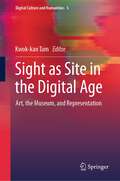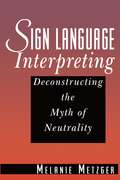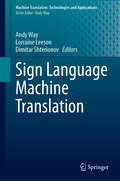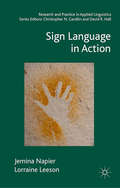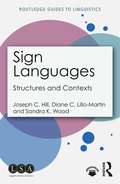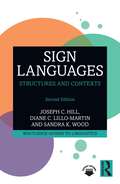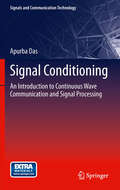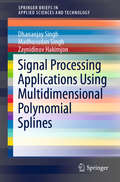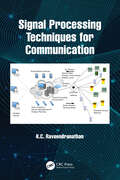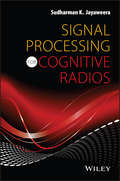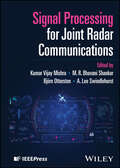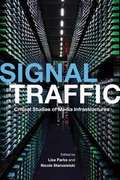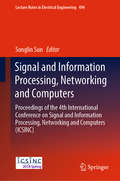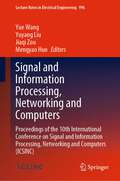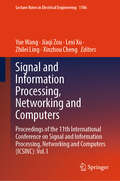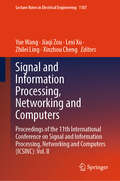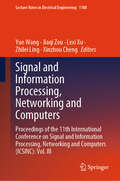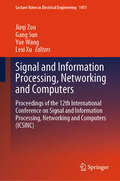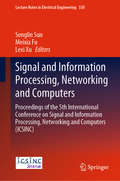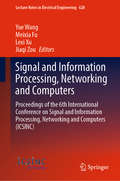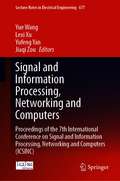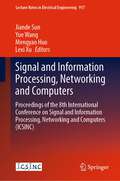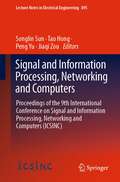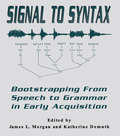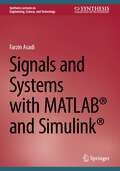- Table View
- List View
Sight as Site in the Digital Age: Art, the Museum, and Representation (Digital Culture and Humanities #5)
by Kwok-Kan TamThis volume presents a broad coverage of theoretical issues that deal with digital culture, representation and ideology in art and museums, and other cultural sites, offering new insights into issues of representation in the digitization of art. It critically examines the roles of museum and archives in the digital age and reexamines the intricate relations between sight and site in art, museums, exhibitions, theme parks, theatre performances, music videos, and films. The collection represents a multidisciplinary approach to the complex issues underlying the advent of technologies and digital culture. The rise of visual culture since the twentieth century can be accounted for by the advent of technology in film, TV, museum exhibitions, and the wide use of websites, but it can also be understood as a paradigmatic shift toward representation as a visual means to interpret culture, with new understandings of the site-sight dilemma and the co-implications in related tensions. Complicating the issue of representation is the rise of digital culture, as digital sites replace actual physical sites. This book explores how the virtual has replaced the actual, and in what ways, and to what effects, the digital has displaced the physical. With contributions by museum curators, communications scholars, visual artists, theatre artists, filmmakers, literary critics, and historians, this volume is of appeal to academics and graduate students in information science, art, media, performance, literary and cultural studies, and history. “The book binds together different concepts such as site, sight and digitalization in a very original way. It convincingly gathers contributions from academics and practitioners, artists and museum specialists. The chapters are theoretically well-founded, show an interesting breadth of content and are also dealing with current developments.”— Monika Gänssbauer, Professor of Chinese and Head of the Institute of Asian, Middle Eastern and Turkish Studies, Stockholm University, Sweden “The chapters raise important and latest questions and discussions on the impact of digital technology has on art, culture, creativity, representation and innovation. They are original in dealing with latest examples in recent years, especially during the pandemic, with reflections and philosophical discussions on the transformation digital culture undergoes in relation to human and posthuman contexts, with examinations of art works, archives and museum collections, exhibitions, theme parks, theatre performances, films and music videos that encompass cultures from ancient to contemporary, from the West to the East, and from physical to digital.”— Jack Leong, Associate Dean of Research and Open Scholarship, York University Libraries, Toronto, Canada
Sign Language Interpreting: Deconstructing the Myth of Neutrality (Gallaudet Studies In Interpret Ser. #9)
by Melanie MetzgerAs with all professional interpreters, sign language interpreters strive to achieve the proper protocol of complete objectivity and accuracy in their translation without influencing the interaction in any way. Yet, Melanie Metzger's significant work Sign Language Interpreting: Deconstructing the Myth of Neutrality demonstrates clearly that the ideal of an interpreter as a neutral language conduit does not exist. Metzger offers evidence of this disparity by analyzing two videotaped ASL-English interpreted medical interviews, one an interpreter-trainee mock interview session, and the other an actual encounter between a deaf client and a medical professional. Sign Language Interpreting relies upon an interactional sociolinguistic approach to ask fundamental questions regarding interpreter neutrality. First, do interpreters influence discourse, and if so, how? Also, what kind of expectations do the participants bring to the event, and what do the interpreters bring to discussions? Finally, how do their remarks affect their alignment with participants in the interaction? Using careful assessments of how these interviews were framed, and also re-interviewing the participants for their perspectives, this penetrating book discloses the ways in which interpreters influence these situations. It also addresses the potential implications of these findings regarding sign language interpretation in medical, educational, and all other general interactions. Interpreter trainers and their students will join certified interpreters and Deaf studies scholars in applauding and benefiting from the fresh ground broken by this provocative study.
Sign Language Machine Translation (Machine Translation: Technologies and Applications #5)
by Lorraine Leeson Andy Way Dimitar ShterionovThis book, for the first time, collects important current topics in the area of sign language translation in a single volume. The topic is introduced more generally to benefit newcomers to the field before diving into the current state-of-the-art methods of Sign Language Machine Translation (SLMT), together with an in-depth description of issues specific to this topic, including: an introduction to and historical overview of SLMT; ethical issues related to the engagement of and with deaf users; the importance of data; the sign languages of Europe; sign language recognition and synthesis, including via avatars; data-driven and linguistically-informed models of SLMT; gloss translation; fingerspelling; SLMT communication; and SLMT in practice. Of interest to MT developers and users as well as people working in deaf studies, this volume presents cutting-edge research on machine translation in the field of deaf studies.
Sign Language in Action (Research and Practice in Applied Linguistics)
by Jemina Napier Lorraine LeesonThis book defines the notion of applied sign linguistics by drawing on data from projects that have explored sign language in action in various domains. The book gives professionals working with sign languages, signed language teachers and students, research students and their supervisors, authoritative access to current ideas and practice.
Sign Languages: Structures and Contexts (Routledge Guides to Linguistics #13)
by Joseph C. Hill Diane C. Lillo-Martin Sandra K. WoodSign Languages: Structures and Contexts provides a succinct summary of major findings in the linguistic study of natural sign languages. Focusing on American Sign Language (ASL), this book: offers a comprehensive introduction to the basic grammatical components of phonology, morphology, and syntax with examples and illustrations; demonstrates how sign languages are acquired by Deaf children with varying degrees of input during early development, including no input where children create a language of their own; discusses the contexts of sign languages, including how different varieties are formed and used, attitudes towards sign languages, and how language planning affects language use; is accompanied by e-resources, which host links to video clips. Offering an engaging and accessible introduction to sign languages, this book is essential reading for students studying this topic for the first time with little or no background in linguistics.
Sign Languages: Structures and Contexts (Routledge Guides to Linguistics)
by Joseph C. Hill Sandra K. Wood Diane C. Lillo-MartinSign Languages: Structures and Contexts provides a succinct summary of major findings in the linguistic study of natural sign languages. Focusing on American Sign Language (ASL), this book offers a comprehensive introduction to the basic grammatical components of phonology, morphology, and syntax with examples and illustrations.Revised throughout, this new edition: demonstrates how sign languages are acquired by Deaf children with varying degrees of input during early development, including no input where children create a language of their own discusses the contexts of sign languages, including how different varieties are formed and used, attitudes toward sign languages, and how language planning affects language use includes a new chapter on the similarities between signed and spoken languages offers additional visuals and explanations as well as more coverage of signed languages other than ASL is accompanied by updated online support material, which hosts links to video clips This engaging and accessible introduction to sign languages is essential reading for students studying this topic for the first time with little or no background in linguistics.
Signal Conditioning
by Apurba Das"Signal Conditioning" is a comprehensive introduction to electronic signal processing. The book presents the mathematical basics including the implications of various transformed domain representations in signal synthesis and analysis in an understandable and lucid fashion and illustrates the theory through many applications and examples from communication systems. The ease to learn is supported by well-chosen exercises which give readers the flavor of the subject. Supplementary electronic material is available on http://extras.springer.com including MATLAB codes illuminating applications in the domain of one dimensional electrical signal processing, image processing, and speech processing. The book is an introduction for students with a basic understanding in engineering or natural sciences.
Signal Processing Applications Using Multidimensional Polynomial Splines (SpringerBriefs in Applied Sciences and Technology)
by Madhusudan Singh Dhananjay Singh Zaynidinov HakimjonThis book highlights new methods, algorithms and software for the digital processing and recovery of signals. In addition, it describes a new method for modeling one dimensional and multidimensional signals as successions of local polynomial splines and their spectral characteristics. It provides examples of how the proposed methods can be applied in specific cases, together with signal processing software examples in the MATLAB environment, and models of special processes in the Simulink environment. The book’s goal is to make it easier for beginners to understand the subject matter; it is intended for engineers, undergraduate and graduate students engaged in research or the evaluation and design of hardware and software for the digital processing and recovery of signals.
Signal Processing Techniques for Communication
by K.C. RaveendranathanThe reference text discusses signal processing tools and techniques used for the design, testing, and deployment of communication systems. It further explores software simulation and modeling tools like MATLAB, GNU Octave, Mathematica, and Python for modeling, simulation, and detailed analysis leading to comprehensive insights into communication systems. The book explains topics such as source coding, pulse demodulation systems, and the principle of sampling and aliasing.This book: Discusses modern techniques including analog and digital filter design, and modulation principles including quadrature amplitude modulation, and differential phase shift keying. Covers filter design using MATLAB, system simulation using Simulink, signal processing toolbox, linear time-invariant systems, and non-linear time-variant systems. Explains important pulse keying techniques including Gaussian minimum shift keying and quadrature phase shift keying. Presents signal processing tools and techniques for communication systems design, modeling, simulation, and deployment. Illustrates topics such as software-defined radio (SDR) systems, spectrum sensing, and automated modulation sensing. The text is primarily written for senior undergraduates, graduate students, and academic researchers in the fields of electrical engineering, electronics and communication engineering, computer science, and engineering.
Signal Processing for Cognitive Radios
by Sudharman K. JayaweeraThis book examines signal processing techniques for cognitive radios. The book is divided into three parts:Part I, is an introduction to cognitive radios and presents a history of the cognitive radio (CR), and introduce their architecture, functionalities, ideal aspects, hardware platforms, and state-of-the-art developments. Dr. Jayaweera also introduces the specific type of CR that has gained the most research attention in recent years: the CR for Dynamic Spectrum Access (DSA).Part II of the book, Theoretical Foundations, guides the reader from classical to modern theories on statistical signal processing and inference. The author addresses detection and estimation theory, power spectrum estimation, classification, adaptive algorithms (machine learning), and inference and decision processes. Applications to the signal processing, inference and learning problems encountered in cognitive radios are interspersed throughout with concrete and accessible examples.Part III of the book, Signal Processing in Radios, identifies the key signal processing, inference, and learning tasks to be performed by wideband autonomous cognitive radios. The author provides signal processing solutions to each task by relating the tasks to materials covered in Part II. Specialized chapters then discuss specific signal processing algorithms required for DSA and DSS cognitive radios.
Signal Processing for Joint Radar Communications (IEEE Press)
by Kumar Vijay Mishra A. Lee Swindlehurst M. R. Bhavani Shankar Björn OtterstenSignal Processing for Joint Radar Communications A one-stop, comprehensive source for the latest research in joint radar communications In Signal Processing for Joint Radar Communications, four eminent electrical engineers deliver a practical and informative contribution to the diffusion of newly developed joint radar communications (JRC) tools into the sensing and communications communities. This book illustrates recent successes in applying modern signal processing theories to core problems in JRC. The book offers new results on algorithms and applications of JRC from diverse perspectives, including waveform design, physical layer processing, privacy, security, hardware prototyping, resource allocation, and sampling theory. The distinguished editors bring together contributions from more than 40 leading JRC researchers working on remote sensing, electromagnetics, optimization, signal processing, and beyond 5G wireless networks. The included resources provide an in-depth mathematical treatment of relevant signal processing tools and computational methods allowing readers to take full advantage of JRC systems. Readers will also find: Thorough introductions to fundamental limits and background on JRC theory and applications, including dual-function radar communications, cooperative JRC, distributed JRC, and passive JRCComprehensive explorations of JRC processing via waveform analyses, interference mitigation, and modeling with jamming and clutterPractical discussions of information-theoretic, optimization, and networking aspects of JRCIn-depth examinations of JRC applications in cutting-edge scenarios including automotive systems, intelligent reflecting surfaces, and secure parameter estimation Perfect for researchers and professionals in the fields of radar, signal processing, communications, information theory, networking, and electronic warfare, Signal Processing for Joint Radar Communications will also earn a place in the libraries of engineers working in the defense, aerospace, wireless communications, and automotive industries.
Signal Traffic: Critical Studies of Media Infrastructures (The Geopolitics of Information)
by Nicole Starosielski Lisa ParksThe contributors to Signal Traffic investigate how the material artifacts of media infrastructure--transoceanic cables, mobile telephone towers, Internet data centers, and the like--intersect with everyday life. Essayists confront the multiple and hybrid forms networks take, the different ways networks are imagined and engaged with by publics around the world, their local effects, and what human beings experience when a network fails. Some contributors explore the physical objects and industrial relations that make up an infrastructure. Others venture into the marginalized communities orphaned from the knowledge economies, technological literacies, and epistemological questions linked to infrastructural formation and use. The wide-ranging insights delineate the oft-ignored contrasts between industrialized and developing regions, rich and poor areas, and urban and rural settings, bringing technological differences into focus. Contributors include Charles R. Acland, Paul Dourish, Sarah Harris, Jennifer Holt and Patrick Vonderau, Shannon Mattern, Toby Miller, Lisa Parks, Christian Sandvig, Nicole Starosielski, Jonathan Sterne, and Helga Tawil-Souri.
Signal and Information Processing, Networking and Computers: Proceedings Of The 3rd International Conference On Signal And Information Processing, Networking And Computers (icsinc) (Lecture Notes In Electrical Engineering #473)
by Songlin SunThis proceedings book presents selected papers from the 4th Conference on Signal and Information Processing, Networking and Computers (ICSINC) held in Qingdao, China on May 23–25, 2018. It focuses on the current research in a wide range of areas related to information theory, communication systems, computer science, signal processing, aerospace technologies, and other related technologies. With contributions from experts from both academia and industry, it is a valuable resource anyone interested in this field.
Signal and Information Processing, Networking and Computers: Proceedings of the 10th International Conference on Signal and Information Processing, Networking and Computers (ICSINC) (Lecture Notes in Electrical Engineering #996)
by Yue Wang Jiaqi Zou Mengyao Huo Yuyang LiuThis book collects selected papers from the 10th Conference on Signal and Information Processing, Networking and Computers held in Xi’Ning, China held in July, 2022. The book focuses on the current works of information theory, communication system, computer science, aerospace technologies and big data and other related technologies. People from both academia and industry of this field can contribute and find their interests from the book.
Signal and Information Processing, Networking and Computers: Proceedings of the 11th International Conference on Signal and Information Processing, Networking and Computers (ICSINC): Vol. I (Lecture Notes in Electrical Engineering #1186)
by Yue Wang Lexi Xu Jiaqi Zou Zhilei Ling Xinzhou ChengThis book collects selected papers from the 11th Conference on Signal and Information Processing, Networking and Computers held in Chengdu, China, in September 2023. The book focuses on the current works of information theory, communication system, computer science, aerospace technologies, big data, and other related technologies. People from both academia and industry of these fields can contribute and find their interests from the book. The 11th International Conference on Signal and Information Processing, Networking and Computers (ICSINC) was held in Chengdu, China, in September 2023, which focused on the key technologies and challenges of signal and information processing schemes, network application, computer theory, space technologies, big data, and other related technologies
Signal and Information Processing, Networking and Computers: Proceedings of the 11th International Conference on Signal and Information Processing, Networking and Computers (ICSINC): Vol. II (Lecture Notes in Electrical Engineering #1187)
by Yue Wang Lexi Xu Jiaqi Zou Zhilei Ling Xinzhou ChengThis book collects selected papers from the 11th Conference on Signal and Information Processing, Networking and Computers held in Chengdu, China, in September 2023. The book focuses on the current works of information theory, communication system, computer science, aerospace technologies, big data, and other related technologies. People from both academia and industry of these fields can contribute and find their interests from the book. The 11th International Conference on Signal and Information Processing, Networking and Computers (ICSINC) was held in Chengdu, China, in September 2023, which focused on the key technologies and challenges of signal and information processing schemes, network application, computer theory, space technologies, big data, and other related technologies
Signal and Information Processing, Networking and Computers: Proceedings of the 11th International Conference on Signal and Information Processing, Networking and Computers (ICSINC): Vol. III (Lecture Notes in Electrical Engineering #1188)
by Yue Wang Lexi Xu Jiaqi Zou Zhilei Ling Xinzhou ChengThis book collects selected papers from the 11th Conference on Signal and Information Processing, Networking and Computers held in Chengdu, China, in September 2023. The book focuses on the current works of information theory, communication system, computer science, aerospace technologies, big data, and other related technologies. People from both academia and industry of these fields can contribute and find their interests from the book.The 11th International Conference on Signal and Information Processing, Networking and Computers (ICSINC) was held in Chengdu, China, in September 2023, which focused on the key technologies and challenges of signal and information processing schemes, network application, computer theory, space technologies, big data, and other related technologies
Signal and Information Processing, Networking and Computers: Proceedings of the 12th International Conference on Signal and Information Processing, Networking and Computers (ICSINC) (Lecture Notes in Electrical Engineering #1411)
by Yue Wang Lexi Xu Jiaqi Zou Gang SunThis proceedings book presents the latest research in the fields of signal and information processing schemes, computer theory, space technologies, big data, as well as other related technologies. Collecting selected papers from the 12th Conference on Signal and Information Processing, Networking and Computers (ICSINC), is held in Chongqing, China, on September 10–13, 2024, it is of interest to professionals from academia and industry alike.
Signal and Information Processing, Networking and Computers: Proceedings of the 5th International Conference on Signal and Information Processing, Networking and Computers (ICSINC) (Lecture Notes in Electrical Engineering #550)
by Songlin Sun Meixia Fu Lexi XuThis proceedings book presents selected papers from the 5th Conference on Signal and Information Processing, Networking and Computers (ICSINC), held in Yuzhou, China, from November 29 to December 1, 2018. It focuses on the current research in a wide range of areas in the fields of information theory, communication systems, computer science, signal processing, aerospace technologies, and other related technologies. With contributions from experts from both academia and industry, it is a valuable resource for anyone who is interested in this field.
Signal and Information Processing, Networking and Computers: Proceedings of the 6th International Conference on Signal and Information Processing, Networking and Computers (ICSINC) (Lecture Notes in Electrical Engineering #628)
by Yue Wang Meixia Fu Lexi Xu Jiaqi ZouThis book collects selected papers from the 6th Conference on Signal and Information Processing, Networking and Computers, held in Guiyang, China, on August 13 - 16, 2019. Focusing on the latest advances in information theory, communication systems, computer science, aerospace technologies, big data and other related technologies, it offers a valuable resource for researchers and industrial practitioners alike.
Signal and Information Processing, Networking and Computers: Proceedings of the 7th International Conference on Signal and Information Processing, Networking and Computers (ICSINC) (Lecture Notes in Electrical Engineering #677)
by Yue Wang Lexi Xu Jiaqi Zou Yufeng YanThis book collects selected papers from the 7th Conference on Signal and Information Processing, Networking and Computers held in Rizhao, China, on September, 2020.The 7th International Conference on Signal and Information Processing, Networking and Computers (ICSINC) was held in Rizhao, China, on September, 2020.
Signal and Information Processing, Networking and Computers: Proceedings of the 8th International Conference on Signal and Information Processing, Networking and Computers (ICSINC) (Lecture Notes in Electrical Engineering #917)
by Yue Wang Lexi Xu Jiande Sun Mengyao HuoThis book collects selected papers from the 8th Conference on Signal and Information Processing, Networking and Computers held in Ji’nan, Shandong, China on September 13-17, 2021. It focuses on the current works of information theory, communication system, computer science, aerospace technologies and big data and other related technologies. Readers from both academia and industry of this field can contribute and find their interests from the book.
Signal and Information Processing, Networking and Computers: Proceedings of the 9th International Conference on Signal and Information Processing, Networking and Computers (ICSINC) (Lecture Notes in Electrical Engineering #895)
by Songlin Sun Jiaqi Zou Peng Yu Tao HongThis book collects selected papers from the 9th Conference on Signal and Information Processing, Networking and Computers held online, in December, 2021. The book focuses on the current works of information theory, communication system, computer science, aerospace technologies, big data and other related technologies. Readers from both academia and industry of this field can contribute and find their interests from the book.
Signal to Syntax: Bootstrapping From Speech To Grammar in Early Acquisition
by James L. Morgan Katherine DemuthIn the beginning, before there are words, or syntax, or discourse, there is speech. Speech is an infant's gateway to language. Without exposure to speech, no language--or at most only a feeble facsimile of language--develops, regardless of how rich a child's biological endowment for language learning may be. But little is given directly in speech--not words, for example, as anyone who has ever listened to fluent conversation in an unfamiliar language can attest. Rather, words and phrases, or rudimentary categories--or whatever other information is required for syntactic and semantic analyses to begin operating--must be pulled from speech through an infant's developing perceptual capacities. By the end of the first year, an infant can segment at least some words from fluent speech. Beyond this, how impoverished or rich an infant's representations of input may be remains largely unknown. Clearly, in the debate over determinants of early language acquisition, the input speech stream has too often been offhandedly dismissed as a potential source of information.This volume brings together internationally-known scholars from a range of disciplines--linguistics, psychology, cognitive and computer science, and acoustics --who share common interests in how speech, in its phonological, prosodic, distributional, and statistical properties, may encode information useful for early language learning, and how such information may be deciphered by very young children. These scholars offer a spectrum of viewpoints on the possibility that aspects of speech may provide bootstraps for language learning; contribute important, state-of-the-art findings across a variety of relevant domains; and illuminate critical directions for future inquiry. The publication of this volume represents a significant step in renewing the bonds between two fields that have long been sundered--speech perception and language acquisition.
Signals and Systems with MATLAB® and Simulink® (Synthesis Lectures on Engineering, Science, and Technology)
by Farzin AsadiThis textbook provides a compact but comprehensive treatment that guides students to solve Signals and Systems problems using MATLAB®/Simulink®. Ideal as a hands-on source for courses in Signals and Systems or Control Systems, this text focuses on solving problems using market-standard software, corresponding to all key concepts covered in the classroom. The author uses his extensive classroom experience to guide students toward deeper understanding of key concepts, while they gain facility with software they will need to master for later studies and practical use in their engineering careers.
